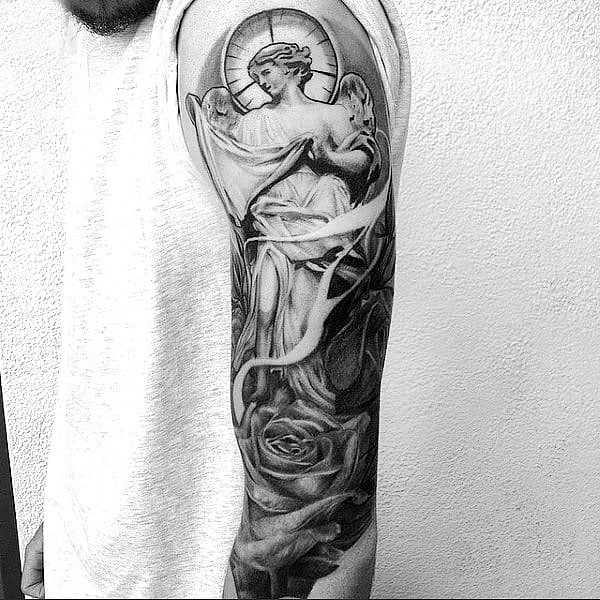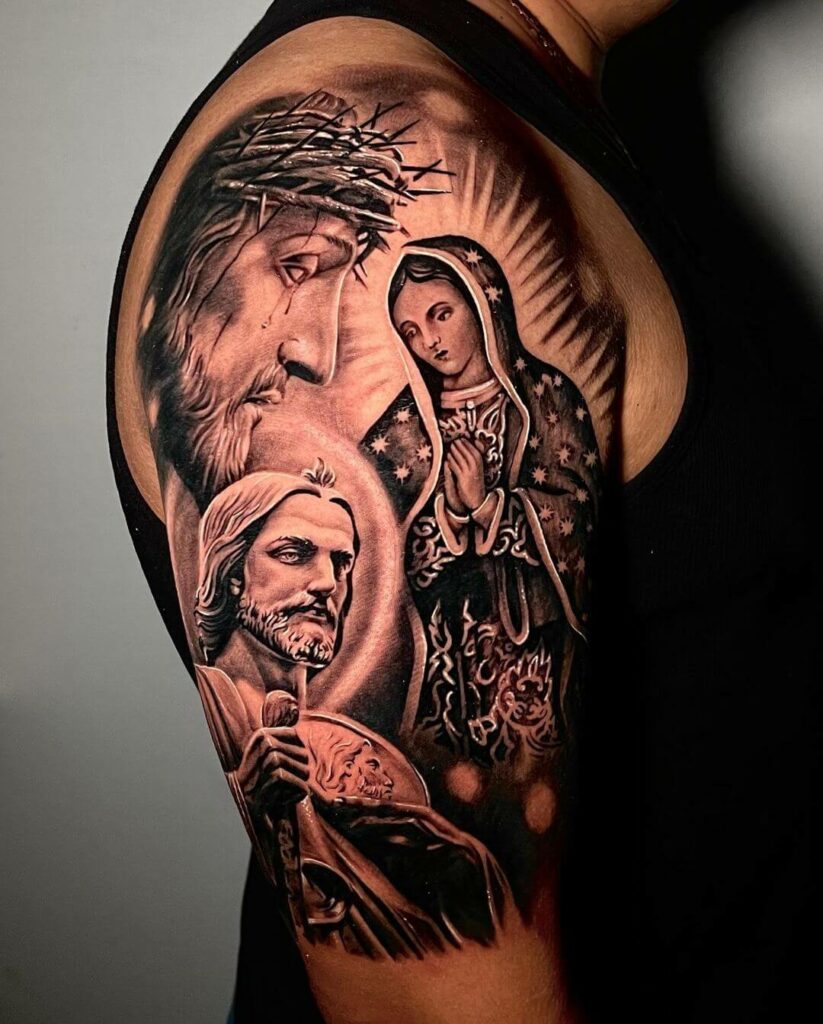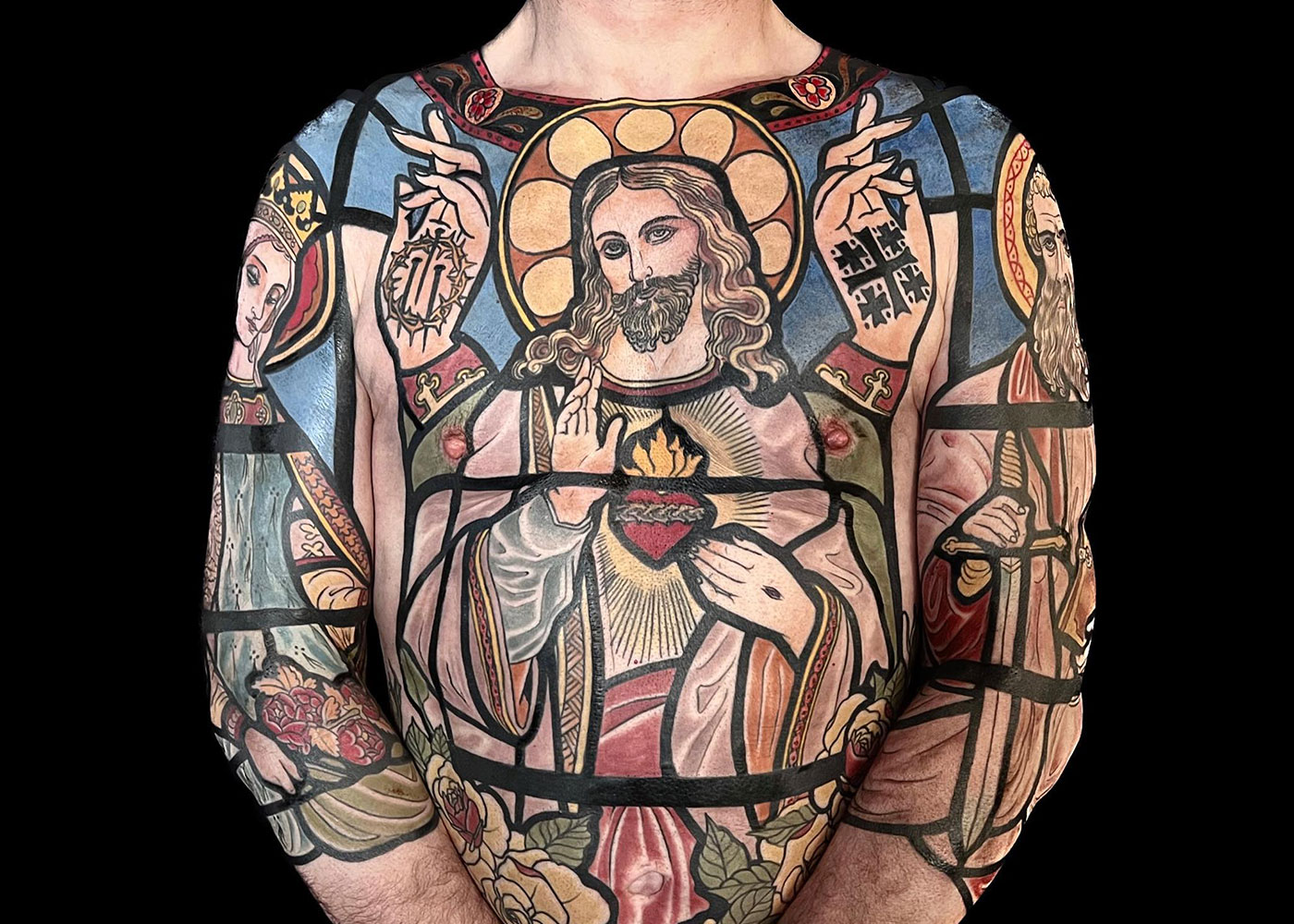Religion sleeve tattoos have become a powerful way for individuals to express their faith and devotion through art. These tattoos often serve as a testament to one's beliefs, creating a deep connection between spirituality and personal identity. As the popularity of religious tattoos continues to grow, understanding their significance and meaning is essential for those considering this form of body art.
For many, religion sleeve tattoos are more than just decorative; they are a reflection of one's values, beliefs, and spiritual journey. These intricate designs often incorporate sacred symbols, holy texts, and imagery that resonate with the wearer's faith. Whether it's Christian, Islamic, Hindu, or any other religious tradition, these tattoos can serve as a constant reminder of one's spiritual commitment.
In this article, we will explore the world of religion sleeve tattoos, including their history, symbolism, design ideas, and cultural significance. We'll also provide practical tips for choosing the right design, finding the perfect artist, and ensuring proper care for your tattoo. Let's dive in and discover the beauty and meaning behind these sacred works of art.
Read also:Famous Gabrielle The Rise To Stardom And Her Remarkable Journey
Table of Contents
- The History of Religion Sleeve Tattoos
- Symbolism in Religious Tattoos
- Design Ideas for Religion Sleeve Tattoos
- Choosing the Right Design
- Finding the Right Tattoo Artist
- Proper Care for Your Religion Sleeve Tattoo
- Cultural Impact of Religion Sleeve Tattoos
- Longevity and Maintenance
- Current Trends in Religious Tattoos
- Conclusion
The History of Religion Sleeve Tattoos
Religion sleeve tattoos have deep historical roots that trace back thousands of years. In ancient cultures, tattoos were often used as a form of spiritual expression and protection. For example, in Egypt, tattoos were found on mummies dating back to 2000 BCE, often depicting religious symbols and deities. Similarly, in Polynesia, tattoos served as a rite of passage and a way to honor the gods.
In Christianity, tattoos have been used since the early days of the faith. Pilgrims returning from the Holy Land often bore tattoos of crosses and other religious symbols as a mark of their journey. During the Middle Ages, tattoos were also used by soldiers and knights as a sign of their devotion to God.
Modern Resurgence
In recent years, there has been a resurgence of interest in religion sleeve tattoos. This is partly due to the increasing acceptance of tattoos in mainstream culture and the desire for people to express their faith in a personal and meaningful way. Modern designs often combine traditional religious symbols with contemporary art styles, creating a unique blend of old and new.
Symbolism in Religious Tattoos
Symbolism plays a crucial role in religion sleeve tattoos. Each design carries specific meanings that are deeply connected to the wearer's faith. Understanding these symbols can help individuals choose designs that resonate with their beliefs and values.
Common Religious Symbols
- Cross: A universal symbol of Christianity, representing sacrifice, redemption, and salvation.
- Om: A sacred sound and symbol in Hinduism, Buddhism, and Jainism, symbolizing the universe and the ultimate reality.
- Star of David: A significant symbol in Judaism, representing the connection between God and the Jewish people.
- Crescent Moon: Often associated with Islam, symbolizing the Islamic calendar and the faith's connection to the divine.
Design Ideas for Religion Sleeve Tattoos
When it comes to religion sleeve tattoos, the possibilities for design are virtually endless. From intricate mandalas to detailed scenes from holy texts, there are countless ways to express one's faith through art. Below are some popular design ideas:
Incorporating Sacred Texts
Many people choose to include excerpts from holy texts in their religion sleeve tattoos. For Christians, this might involve verses from the Bible, while Muslims may opt for passages from the Quran. These texts can be written in the original language or translated into the wearer's native tongue, adding a personal touch to the design.
Read also:Vegamoviesrs Your Ultimate Destination For Entertainment
Choosing the Right Design
Selecting the right design for your religion sleeve tattoo is an important decision. It's essential to consider factors such as personal significance, placement on the body, and the artist's style. Here are some tips to help you make the best choice:
- Research different design options and gather inspiration from online galleries and social media platforms.
- Consult with your tattoo artist to discuss your ideas and ensure they align with your vision.
- Consider the size and complexity of the design, as sleeve tattoos can be quite large and detailed.
Finding the Right Tattoo Artist
Choosing the right tattoo artist is crucial for achieving a high-quality religion sleeve tattoo. Look for artists who specialize in religious or spiritual designs and have a portfolio showcasing their work. It's also important to ensure that the artist is licensed and follows proper hygiene practices.
Questions to Ask Your Artist
- What experience do you have with religious tattoos?
- Can you provide references or examples of previous work?
- What is your process for ensuring proper sterilization and safety?
Proper Care for Your Religion Sleeve Tattoo
Once your religion sleeve tattoo is complete, proper care is essential to ensure it heals correctly and maintains its vibrant colors. Follow these tips to keep your tattoo looking its best:
- Keep the tattoo clean and moisturized during the healing process.
- Avoid exposing the tattoo to direct sunlight or swimming in pools for at least two weeks.
- Regularly apply a high-quality tattoo aftercare product to promote healing.
Cultural Impact of Religion Sleeve Tattoos
Religion sleeve tattoos have a significant cultural impact, reflecting the diverse ways in which people express their faith. In some cultures, these tattoos are seen as a form of spiritual protection, while in others, they serve as a public declaration of one's beliefs. As society becomes more accepting of body art, religion sleeve tattoos continue to gain popularity as a means of personal and cultural expression.
Acceptance and Perception
While religion sleeve tattoos are widely accepted in many communities, they can still face stigma in certain environments. It's important for individuals to consider how their tattoo may be perceived in different contexts and to be prepared to explain its significance if necessary.
Longevity and Maintenance
The longevity of a religion sleeve tattoo depends on several factors, including the quality of the tattoo itself and the wearer's skin type. Proper maintenance, such as regular moisturizing and avoiding excessive sun exposure, can help preserve the tattoo's colors and details over time.
Tattoo Touch-Ups
Over the years, tattoos may fade or lose their sharpness. Scheduling periodic touch-ups with your artist can help maintain the tattoo's appearance and ensure it continues to reflect your faith and values.
Current Trends in Religious Tattoos
Religious tattoos are constantly evolving, with new trends emerging in design and style. Some of the latest trends include:
- Watercolor techniques that add a soft, ethereal quality to religious symbols.
- Blackwork designs that emphasize bold lines and intricate patterns.
- Minimalist approaches that focus on simplicity and subtlety.
Conclusion
Religion sleeve tattoos offer a profound way for individuals to express their faith and connect with their spirituality. By understanding the history, symbolism, and design options available, you can create a tattoo that truly reflects your beliefs and values. Remember to choose a reputable artist, follow proper care instructions, and consider the cultural impact of your tattoo.
We invite you to share your thoughts and experiences with religion sleeve tattoos in the comments below. If you enjoyed this article, please consider sharing it with others who may find it helpful. For more information on tattoos and body art, explore our other articles and resources.


